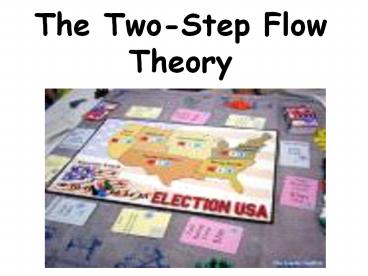The Two-Step Flow Theory - PowerPoint PPT Presentation
Title:
The Two-Step Flow Theory
Description:
The Two-Step Flow Theory In 1948, Paul Lazarsfeld, Bernard Berelson and Hazel Gaudet published The People's Choice a paper analyzing the voters decision-making ... – PowerPoint PPT presentation
Number of Views:1767
Avg rating:3.0/5.0
Title: The Two-Step Flow Theory
1
The Two-Step Flow Theory
2
- In 1948, Paul Lazarsfeld, Bernard Berelson and
Hazel Gaudet published The People's Choice - a paper analyzing the voters decision-making
processes during a 1940 presidential election
campaign.
3
The study revealed evidence suggesting that the
flow of mass communication is less direct than
previously supposed. Although the ability of
mass media to reach a large audience, and in this
case persuade individuals in one direction or
another, had been a topic of much research since
the 1920's, it was not until the People's Choice
was published that society really began to
understand the dynamics of the media-audience
relationship.
4
- The study suggested that communication from the
mass media first reaches "opinion leaders" who
filter the information they gather to their
associates, with whom they are influential. - What did previous theories suggest?
5
- Previous theories assumed that media directly
reached the target of the information. - For the theorists, the opinion leader theory
proved an interesting discovery considering the
relationship between media and its target was not
the focus of the research, but instead a small
aspect of the study.
6
Essentially what Lazarsfeld discovered is that
many voters regard family members and close
personal friends, and not the mass media, as
major influences in the decision making process.
7
These people of influence, who pass on
information received in the media to other people
in society, were coined opinion leaders.
8
Media are seen as
ACTIVE
Audience are seen as
SEMI-ACTIVE
9
Opinion leaders
Individuals in social contact with opinion leader
10
- Do you think this model is slightly misleading?
- Why?
11
- The model is often presented graphically as shown
on the last slide. In fact, that is somewhat
misleading as it suggests that mass media
messages flow first to opinion leaders and from
them to the rest. - Obviously, that's not the case, since you and I
can both receive messages directly. The point is
that the messages we receive are then modified
through the pattern of our social contacts.
12
- If opinion leaders were able to have this effect
on peoples decision, what do you think their
characteristics were?
13
- Opinion Leaders
- Tended to be found at all levels of society
- Were much like the people they led
- Usually had a little more of education, money,
status than follower - Knew more than others in the group
- Often had a strategic location where they met
lots of people
14
- Who do you regularly turn to for information?
- Whose opinion do you regard as able to change
your own? - Have you yourself changed anybodys opinions
about anything? - Who are your personal opinion leaders?
15
This early research was later developed by Katz
and Lazarsfeld and presented in their book
Personal Influence (1955). A number of
significant conclusions follow from their
research
16
- Our responses to media messages will be mediated
through our social relationships. The effects of
media messages being sharply limited by
interpersonal relationships and group membership. - It is misleading to think of receivers as members
of a 'mass audience' since that implies that they
are all equal in their reception of media
messages, whereas in fact some play a more active
role than others.
17
- Receiving a message does not imply responding to
it nor does non-reception imply non-response
(since we may still receive the message via
interpersonal communication). - There are some people amongst the media audience
who act as opinion leaders (typically such people
use the mass media more than the average) mix
more than the average across social classes and
see themselves and are seen by others as having
an influence on others.
18
The term personal influence was coined to refer
to the process intervening between the medias
direct message and the audiences ultimate
reaction to that message. Opinion leaders are
quite influential in getting people to change
their attitudes and behaviours and are quite
similar to those they influence. The Two-Step
Flow Theory has improved our understanding of how
the mass media influence decision making.
19
The theory refined the ability to predict the
influence of media messages on audience
behaviour, and it helped explain why certain
media campaigns may have failed to alter audience
attitudes and behaviour.
20
- What do you think are the strengths of this
model? - What do you think are the weaknesses of this
model?
21
- Strength
- The model examines the way that personal
relationships may help to mediate messages from
the media - Weakness
- It doesnt explain why opinion leaders should be
active































